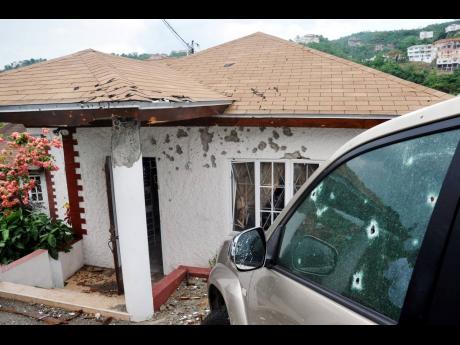Expert witness details blood spatter patterns in Clarke murder case
Highlighting the intricate details of the crime scene, a former government forensic analyst on Thursday provided crucial insights into the positioning and nature of blood spatters found in the master bedroom of Keith Clarke's residence after he was shot dead 14 years ago.
She is the first of the nine witnesses who the prosecution indicated earlier this week that it would be bringing to the Home Circuit Court for examination in chief as the murder trial continues.
“The blood spatters on the items of clothing from inside the closet as well as on the eastern wall to the back of the closet, they suggested that Clarke could have been injured whilst in an upright position as opposed to lying down,” the witness said on Thursday in response to a question by prosecutor Dwayne Green.
“The blood spatter on the northern wall, which is to the end wall of the closet, was at a low level, which suggests that Clarke could have been injured whilst lying on the floor or that he sustained injury to the lower part of his body, such as his leg, whilst in an upright position,” she said.
She further explained that Clarke could have been injured while in an upward position based on the height of the blood stains.
Green asked the witness how she had arrived at the conclusion that the blood spatter on the northern wall suggested that Clarke could have been injured while on the floor.
“So those were at a much lower level, so it’s either he was injured at a lower portion of his body, like the leg, and it spattered on the walll, or he was pretty much low down on the ground at the time he was injured,” she said.
Green further asked the witness to explain how she concluded that Clarke sustained injury to the lower part of his body while in an upright position.
Using the back wall of the courtroom to demonstrate, she explained that the blood spatter on the northern wall of the closet was at a lower level.
“Based on the shape of the blood drops, you could tell the direction the blood actually impacted the wall. From the bleeding source to the wall, it was coming down in a going-down or downward position,” she said.
She said that she tested the master bedroom with the Kastle–Meyer kit – one of the two main classes of forensic tests commonly employed by crime labs. The witness said it was a combination of three liquids, and she used glutton paper to touch and lift some of the stains from the wall. She also added reagents, and they were taken to a laboratory for further analysis.
“This test is not a confirmative test. It’s a presumptive test to suggest that the drops I saw on the wall I tested could be blood … . I only was able to determine the sex or the gender of the [source of the] blood stain, which was male - human male. So that confirmed that it was human blood,” she said.
She further reiterated that Clarke was either in an upright position when he got shot in the lower section of the body and the blood spattered on the wall, or he was lying low when he got injured and the blood spattered.
The witness advised the court that she visited the Clarkes' residence on October 10, 2010, but based on the length of time between her visit and when the incident occurred, it could have impacted the evidence that she had to examine.
“For one, the blood stain would have been far less degraded, would be more intact and likely to give a more conclusive result in terms of DNA, and based on my observations, I did mention that the scene was disturbed,” she said.
Meanwhile, Justice Dale Palmer and the defence expressed to the prosecution that they did not wish to go into the next court term, which starts in September, without a ruling.
The case has been ongoing since 2012 when chief prosecutor Paula Llewellyn ruled that three soldiers – lance corporals Greg Tingling and Odel Buckley, as well as private Arnold Henry – be charged for killing Clarke at his home.
Clarke was shot 21 times on March 27, 2010, during a police-military operation to apprehend then-fugitive drug lord Christopher 'Dudus' Coke.
Ainsworth Morris and Morica Parkinson

